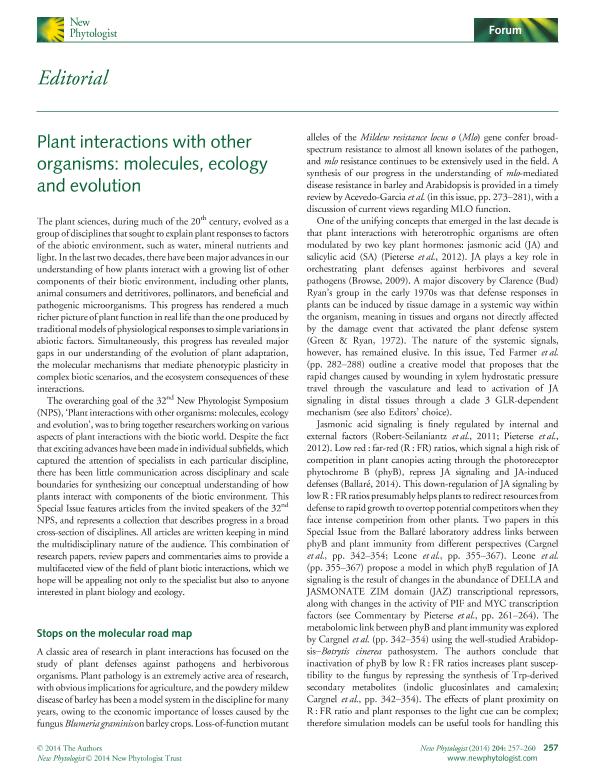Mostrar el registro sencillo del ítem
dc.contributor.author
Austin, Amy Theresa

dc.contributor.author
Ballare, Carlos Luis

dc.date.available
2016-02-05T20:02:50Z
dc.date.issued
2014-09-18
dc.identifier.citation
Austin, Amy Theresa; Ballare, Carlos Luis; Plant interactions with other organisms: molecules, ecology and evolution; Wiley; New Phytologist; 204; 2; 18-9-2014; 257-260
dc.identifier.issn
0028-646X
dc.identifier.uri
http://hdl.handle.net/11336/4088
dc.description.abstract
The plant sciences, during much of the 20th century, evolved as a group of disciplines that sought to explain plant responses to factors of the abiotic environment, such as water, mineral nutrients and light. In the last two decades, there have been major advances in our understanding of how plants interact with a growing list of other components of their biotic environment, including other plants, animal consumers and detritivores, pollinators, and beneficial and pathogenic microorganisms. This progress has rendered a much richer picture of plant function in real life than the one produced by traditional models of physiological responses to simple variations in abiotic factors. Simultaneously, this progress has revealed major gaps in our understanding of the evolution of plant adaptation, the molecular mechanisms that mediate phenotypic plasticity in complex biotic scenarios, and the ecosystem consequences of these interactions.
dc.format
application/pdf
dc.language.iso
eng
dc.publisher
Wiley

dc.rights
info:eu-repo/semantics/openAccess
dc.rights.uri
https://creativecommons.org/licenses/by-nc-sa/2.5/ar/
dc.subject
Biotic Interactions
dc.subject
Defense
dc.subject
Decomposition
dc.subject
Microbe
dc.subject.classification
Ecología

dc.subject.classification
Ciencias Biológicas

dc.subject.classification
CIENCIAS NATURALES Y EXACTAS

dc.title
Plant interactions with other organisms: molecules, ecology and evolution
dc.type
info:eu-repo/semantics/article
dc.type
info:ar-repo/semantics/artículo
dc.type
info:eu-repo/semantics/publishedVersion
dc.date.updated
2016-03-30 10:35:44.97925-03
dc.journal.volume
204
dc.journal.number
2
dc.journal.pagination
257-260
dc.journal.pais
Estados Unidos

dc.journal.ciudad
Hoboken
dc.description.fil
Fil: Austin, Amy Theresa. Consejo Nacional de Investigaciones Científicas y Técnicas. Oficina de Coordinación Administrativa Parque Centenario. Instituto de Investigaciones Fisiológicas y Ecológicas Vinculadas a la Agricultura; Argentina. Consejo Nacional de Investigaciones Científicas y Técnicas. Centro Científico Tecnológico La Plata. Instituto de Investigaciones Biotecnológicas - Instituto Tecnológico Chascomús. Instituto de Investigaciones Biotecnológicas (sede Chascomús); Argentina
dc.description.fil
Fil: Ballare, Carlos Luis. Consejo Nacional de Investigaciones Científicas y Técnicas. Oficina de Coordinación Administrativa Parque Centenario. Instituto de Investigaciones Fisiológicas y Ecológicas Vinculadas a la Agricultura; Argentina. Consejo Nacional de Investigaciones Científicas y Técnicas. Centro Científico Tecnológico La Plata. Instituto de Investigaciones Biotecnológicas - Instituto Tecnológico Chascomús. Instituto de Investigaciones Biotecnológicas (sede Chascomús); Argentina
dc.journal.title
New Phytologist

dc.relation.alternativeid
info:eu-repo/semantics/altIdentifier/url/http://onlinelibrary.wiley.com/doi/10.1111/nph.13062/full
dc.relation.alternativeid
info:eu-repo/semantics/altIdentifier/issn/0028-646X
dc.relation.alternativeid
info:eu-repo/semantics/altIdentifier/doi/http://dx.doi.org/DOI:10.1111/nph.13062
Archivos asociados
